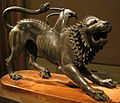| Tinia | |
|---|---|
 Terracotta bust of Tinia from 300–250 BCE | |
| Symbol | Thunderbolt |
| Genealogy | |
| Consort | Uni |
| Children | Hercle and Menrva |
| Equivalents | |
| Greek | Zeus |
| Roman | Jupiter |
| Egyptian | Amun |

Tinia (also Tin, Tinh, Tins or Tina) was the sky god and the highest deity in Etruscan religion, equivalent to the Roman Jupiter and the Greek Zeus. [1]
Contents
However, a primary source from the Roman Varro states that Veltha, not Tins, was the supreme deity of the Etruscans. [2] This has led some scholars to conclude that they were assimilated, but this is speculation. [3]
Tinia was the husband of Uni and the father of Hercle. Like many other Etruscan deities, his name is gender neutral. [4]
The Etruscans had a group of nine gods who had the power of hurling thunderbolts; they were called Novensiles by the Romans. [5] Of thunderbolts there were eleven sorts, of which Tinia wielded three. [5]
Tinia was sometimes represented with a beard or sometimes as youthful and beardless. [3] In terms of symbolism, Tinia has the thunderbolt. [3] [4] Tinia's thunderbolts could be red or blood coloured. [6]
Like Selvans [3] and possibly Laran, [7] Tinia also protected boundaries. His name appears as the guarantor on three boundary stones with identical inscriptions found in Tunisia, originally placed there by the Etruscan colonists. [3]
Some of Tinia's possible epithets are detailed on the Piacenza Liver, a bronze model of a liver used for haruspicy. These inscriptions have been transcribed as Tin Cilens, Tin Θuf and Tinś Θne. There have been a number of suggestions as to their meaning, but the Etruscan language is poorly understood and there is no scholarly consensus for the translation.


